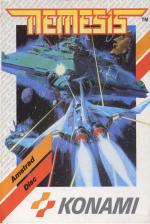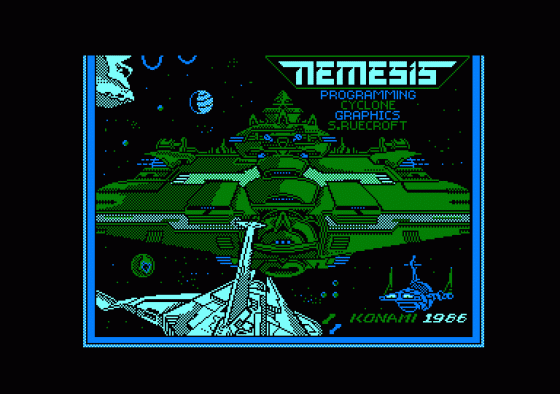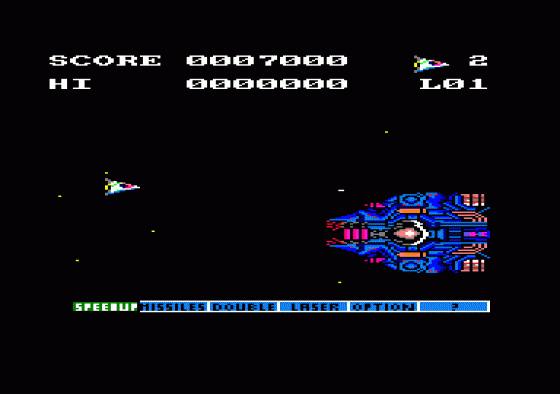
Amstrad Computer User
 1st March 1987
1st March 1987
Categories: Review: Software
Author: Simon Rockman
Publisher: Konami
Machine: Amstrad CPC464
Published in Amstrad Computer User #28
Nemesis: Doing Full Justice To Shoot-'Em-Ups
An in-depth appraisal by Simon Rockman
Konami is big, with new offices in Japan that cost 822m to build. So when the decision was taken to break into the home computer market the company certainly had the backing to do so.
In the past conversions of arcade games have been handled by software houses who buy the rights. So US Gold has Xevious licensed from Atari Coin-Op, Elite has Space Harrier and so on.
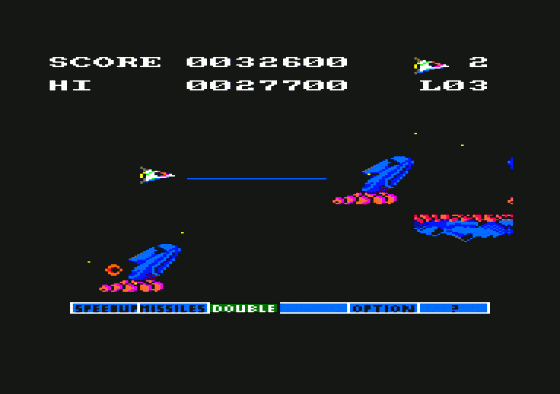
Konami used to licence its games to US Gold, but now uses a management company. In fact a new company was set up for Konami Nemesis Management Consultants (NMC), run by Mike Daniels and Farah Jones of Global software.
NMC finds programmers for projects and supervises conversions. It ensures that games are playable, sprites flickerfree and scrolling smooth.
The Amstrad conversion is the work of Cyclone program conversions, where Steve Lockfell and Dave Whitehorse have been beavering away with screen designers and assemblers to bring Nemesis to the Arnold.

Konami in Japan cannot be expected to know what is going to be a hit in the UK but the company does watch what is going on at home and as a result is most fuksy about MSX versions.
Pride and a keen business sense ensure that NMC keeps up the standard on Amstrad, Commodore and Sinclair computers. Nemesis is the second Konami game which has made it to the Amstrad under the auspices of NMC, the first being Jailbreak.
Nemesis: The Game
Scrolling shoot-'em-up space games have lurked in video cabinets for nearly a decade. Not long after Space Invaders had shuffl ed sideways out of the arcades, games like Scramble and Defender flew in to replace them.

Nemesis looks as though it has been sired by these games. The controls are simpler, with only back, forward, up, down and of course fire to worry about.
But there are many other features which show how games have progressed. The old "extra life at 10.000" incentive scheme seems a bit mean when you discover what you can earn by playing Nemesis. By killing aliens you earn power capsules - which can be traded in for a variety of features.
Points Make Prizes
One power capsule can be traded for extra speed, which makes it easier to avoid bullets and aliens. Two capsules can be swapped for a set of missiles, while three will double your firepower, making it easier to zap the baddies and so earn yet more power capsules.
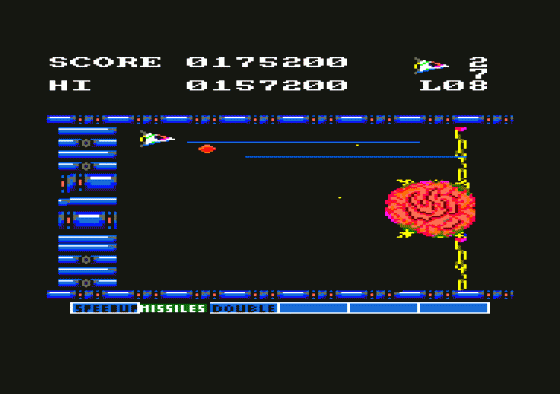
I usually wait until I've got four capsules and can afford a laser: Attack is the best form of defence and I feel a lot safer when wielding a weapon which will slice through the assaulting waves of aliens.
Be careful though. If you should select "double" after earning a laser you'll lose the more powerful weapon.
The way to really double your firepower is described in the screen shots shown here as Option, or in the arcade version as Multiple.

This attaches a drone ship to your main craft which tags along behind, above or below you. This fires and launches missiles as you do - and when you die, it dies.
In fact death is a fate worse than that. Losing a life means that you lose all the power capsules and features you've fought for.
The most expensive spaceship peripheral is a forcelield. At six power capsules it is overpriced, since you can still be shot from behind and it runs out after a time.
Two Few Buttons

A problem constantly faced by programmers converting for home computers is the lack of controls. A keyboard is too unwieldy for fast gameplay so you are stuck with a joystick and one fire button. Nemesis needs three fire buttons.
One to select a feature, one to fire missiles and one to fi re. If you watch experienced players at the arcade machine you'll see that they pound both the fire and missile buttons simultaneously.
The Amstrad version combines these functions, pressing just the joystick button fires all weapons. Selecting a feature is a little more tricky. Jailbreak used the spacebar, but that can be awkward.
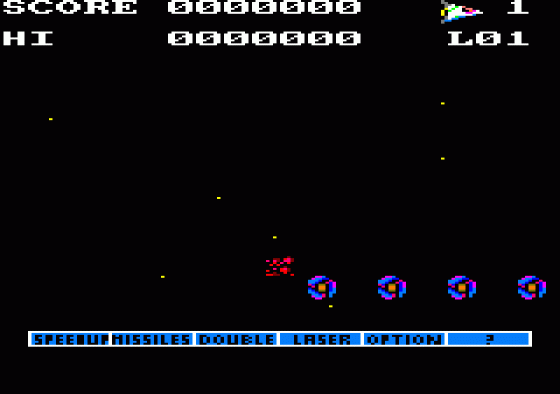
In Nemesis you hold down the fire button to select the highlighted feature. You can end up wasting power capsules when your linger lingers on the button but with a little practice you get used to the system and it is quite workable.
The Task
In the arcade version of Nemesis I've not been able to get much further than the beginning of the second level. That is with a lot of practice and a small fortune invested.
Thanks to a bit of help from NMC and some jiggery pokery, I was able to get a lot further. Still, my arcade experience stood me in good stead for level one.
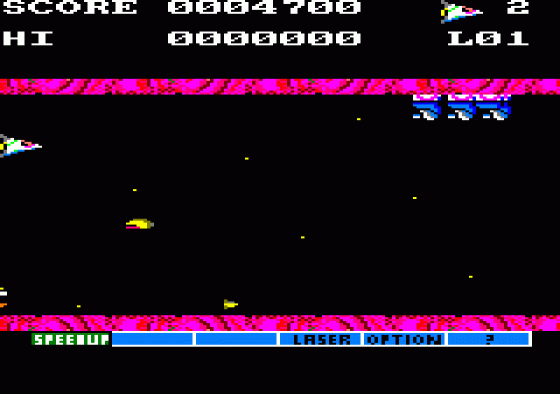
The first alien assault does not fire, but rows of spinning blue buddies come at you five at a time and you need to shoot all of them.
The destruction of each formation of five aliens merits a jewel and by learning the pattern you can soon amass a formidable armament. As they appear the aliens line up, so a laser can slice through the lot with a single burst.
Mastering the wave of seven attacks is important, as this is where you can pick up the power capsules necessary in the big bad world which scrolls on from the right.

The pink marble-like rock encroaches from above and below, guarded by the first firing aliens you'll encounter, swivelling gun emplacements which can be destroyed by cannon fire or missiles.
As a rule the more aliens attacking, the less they fire. This is not a speed restriction: Nemesis plays well, the Amstrad version being one of the fastest.
One kind of alien which looks like a butterfly emerges from a hangar. Killing off individuals is simple enough, but destroying the hangar takes a bit more effort.

One of the more challenging aliens looks like a Dalek on a spring, bouncing to and fro spitting bullets.
You know that you're nearing the end of the first sheet when a mid-air mountain appears and launches a fusillade of large rockets.
It is possible to destroy the rocket launchers but you'll die trying. The best course of action is to the mountain.
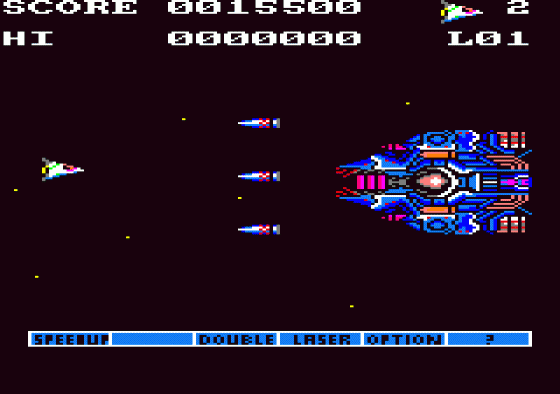
Two volcanos present the last barrier on the first level and they erupt with a vengeance. Missiles are very useful here but, as with the arcade version, just parking your ship as high up as possible is safe enough.
Once the storm has passed you are confronted by a mothership. This appears between each sheet and is protected by a number of shields which have to be shot away before you can destroy the ship.
If you play the game a lot this will become a familiar sight, and practice will provide the skill needed in firing and moving to destroy the ship. All this is crammed into the first of the eight levels. As you progress you'll find more hazards. The second sheet does not offer the three way scroll of the arcade version but it's just as nasty.

You have to shoot through rocks to carve your way past more gun emplacements. Later aliens include a foe which surrounds you and closes in, ships which fire three bullets before they scroll off and large Easter Island style heads.
Level four is the same as level one - but inverted. All those patterns you've learnt now need to be adapted to master this but it provides a good chance to top up on power capsules.
Conclusion
Nemesis is a simple game in concept but has been improved upon to turn it into one of the best shoot-'em-ups to appear on the Amstrad. It's new now but I'm sure that still be playing it in a years time, an accolade which has been awarded to precious few games.
Other Reviews Of Nemesis For The Amstrad CPC464
Nemesis (Konami)
A review by CB (Amstrad Action)
Nemesis (Konami)
A review

